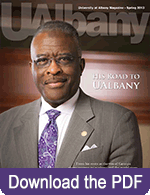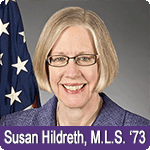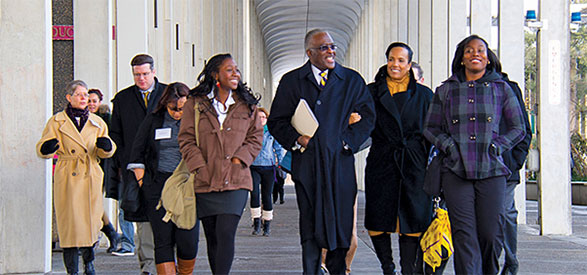
His Road to UAlbany
By Mary Fiess
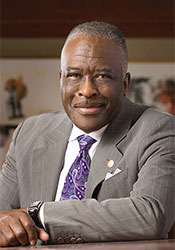
Robert J. Jones, Ph.D.
19th President of the University at Albany
n the wall next to Robert J. Jones’ desk is a photo of him with Nobel laureate Desmond Tutu. The story behind it tells you something about the long road that brought Jones from a boyhood on a sharecroppers’ farm in Georgia to his new calling as the 19th president of the University at Albany.
That road took Jones to a Ph.D. in plant physiology, to a life as faculty member and researcher, to a role as a facilitator in Tutu’s South African Education Program, and to key leadership positions at the University of Minnesota.
On Jan. 2, 2013, the road brought him to UAlbany for his first official day on the job. He was appointed by the SUNY Board of Trustees in September 2012 to succeed retiring president George M. Philip, B.A.’69, M.A.’73.
“When I began my career, I had no interest in ever being a university administrator. I had no intention of being anything other than the best professor, the best scientist, the best scholar I could be,” Jones recalled recently.
So in 1978, he started as an assistant professor in agronomy and plant genetics at the University of Minnesota. Six years later, he was helping Tutu’s education program. Then, along came one key administrative assignment after another at Minnesota. Through all those experiences, he believes he gained an ideal preparation for leading UAlbany.
“I see great opportunities ahead, and I want to bring all my passion and experience to bear in helping to move this University to the next level,” said Jones.
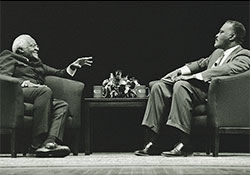
In 2003, Desmond Tutu, the anti-apartheid activist and winner of the Nobel Peace Prize, was the special guest at the University of Minnesota’s Great Conversations program. The auditorium, with a capacity of more than 5,400, was standing room only. Jones, who invited Tutu and interviewed him, recalled the event as “the best conversation. When he’s in the room, you know you are in the presence of an outstanding individual.”
is journey began on a sharecroppers’ farm in Dawson, Ga. “Most years, we could barely make enough to sustain ourselves,” Jones recounted. But they grew their own food and, as a result, “we never went hungry a day in our lives.”
Jones and his brother and sister also “almost never missed a day of school.” At that time, children of sharecropping families sometimes missed school to help harvest the crops. But his parents insisted that their children take their studies seriously – “one of the greatest gifts” they gave him, he said.
“I was always curious as a child,” Jones said. “My high school vocational agriculture teacher, Walter Stallworth, started to call me ‘professor’ when I was in the ninth grade. He made sure I stayed on track with the math and science to get admitted to college.”
At Fort Valley State University, Jones studied agronomy. “I knew it was not going to be in my future to be a farmer, but I saw a very exciting opportunity to be on the other end of that spectrum, looking at the underlying issues in food production from a scientific perspective,” he said. “I took my first plant physiology class as a required course, and I fell in love with it.
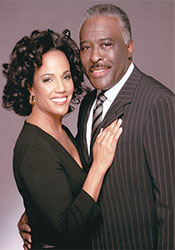
Dr. Jones is married to diagnostic radiologist Lynn Hassan Jones, M.D., whom he introduced to the UAlbany community Jan. 23 as “my better half.”
“I was fortunate to have another mentor at Fort Valley: Malcolm Blunt saw potential in me and three other guys who had also graduated from high school with me. We all went on for advanced degrees.”
Accepted by the University of Georgia, Jones earned his master’s in crop physiology. Then, “one of the world’s best plant/crop physiologists, Curtis Jerry Nelson, recruited me to come to the University of Missouri to do my doctorate. I did well enough my first year that he nominated me for the George Washington Carver Fellowship – and that made all the difference in the world in terms of my ability to pursue my degree and not have to worry about money, for the first time in my life,” Jones said.
The University of Minnesota, “a forerunner in creating multidisciplinary teams of faculty to work on different crops,” hired Jones to start a crop physiology program, working specifically with maize. His research ultimately focused on stabilizing yields of maize in the face of environmental stresses and global climate change as a way of increasing global food production.
Initially, his primary responsibility at Minnesota was setting up his research program, securing grants and hiring staff. He also began teaching a graduate-level plant physiology course.
Jones was pulled into his first administrative assignment at Minnesota in 1986. “The president at the time, Ken Keller, was concerned about whether our predominantly white university was doing enough to create a climate that was supportive of the high-ability students of color we were recruiting,” said Jones.
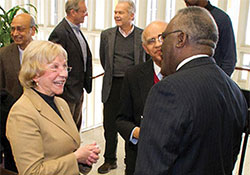
UAlbany faculty and administrators enjoy an informal chat with Dr. Jones.
Remembering the mentors who had helped him, Jones took on a part-time assignment to create and direct the first structured mentoring program for these students. It is still in operation today. “Almost 200 faculty members are involved in helping these students feel at home,” said Jones. “They take the students to lunch, talk to them about their goals, maybe go to a football game together.”
His service on a task force that examined the impact of the university’s strategic plan on its diversity goals and objectives led, in turn, to Jones’ involvement in helping to develop the university’s Office for Equity and Diversity. The man with no desire to become a university administrator assumed his first full-time administrative position – assistant to the associate vice president for Multicultural Affairs and associate provost – in 1994. Three years later, Jones was appointed vice provost for Faculty and Academic Personnel, with responsibilities for managing the university’s promotion and tenure process across the entire five-campus Minnesota system.
In 2002, Jones was named vice president and executive vice provost for Faculty and Academic Programs. Starting in 2004, he served as senior vice president for Academic Administration at the University of Minnesota System.
s he assumed ever greater administrative responsibilities at Minnesota, Jones said, he learned a lot from “the strongest mentor in my academic administrative life,” then president (now emeritus) Robert Bruininks. An innovative, intuitive leader, Bruininks ensured that the university had “the wherewithal and resources necessary to get things done” but was “also very committed to holding people accountable” for their responsibilities.
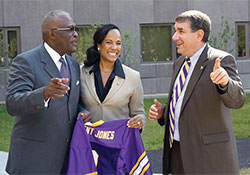
Outgoing University at Albany President George M. Philip shares a laugh with Dr. Jones and his wife.
“He trusted me with a lot of things that could have blown up and caused both of us big trouble,” Jones added. “Particularly, he charged me with going out and driving the university’s urban agenda, articulating a value of the university to serve the urban community. The university had never done anything like that, and not everyone was enthusiastic about it. He provided an opportunity for me to frame the argument. The community’s perception of the university was fundamentally changed.
“Bob gave me the latitude to lead and to innovate, and I hope to provide that kind of space here for my staff members.
Bruininks, in turn, describes Jones as “one of the most extraordinary leaders I have met, nationally and internationally, in higher education. He has all the attributes necessary to be successful in this new and challenging era now facing higher education.
“He was frequently given the most complex and difficult problems to solve and manage to a successful conclusion. He was asked to strengthen the international profile and especially increase the diversity of undergraduate enrollment. In 2007, we had 515 international students. In 2011, we had 2,282. Minnesota won national recognition for becoming one of the more internationally focused public universities,” said Bruininks.
In managing his responsibilities across all five University of Minnesota campuses, Bruininks noted, Jones was able “to really get all parts of the Minnesota university system to work in a more integrative way, to work more productively together. Robert is a leader of considerable vision, courage, integrity. He has great management skills. He is highly inclusive in his leadership style. Diversity isn’t an abstract concept – he embraces diverse ideas, diverse perspectives, people from very diverse backgrounds.”
uch as he had loved his work in Minnesota, when Jones was offered the UAlbany position, he decided to accept it because of the opportunities he sees ahead to build on the University’s excellence. Gov. Andrew Cuomo’s NY SUNY2020 plan, Jones said, is another reason he accepted the UAlbany presidency. “The plan gives us the opportunity to hire some 180 new faculty members and increase our enrollment by more than 1,300 students. It aligns with my vision and passion about how this University needs to be a major player in driving the economic vitality of the region.
“Through our plan, and with the support of the governor, the legislature, SUNY Chancellor Nancy Zimpher and the entire UAlbany family, we have an opportunity to leverage places where we already are excellent to distinguish this University as a leader in emerging technology and entrepreneurship. That will be one of our signature areas because it is multidisciplinary, cutting across many areas.
“Clearly, the task ahead is all about building on the excellence of this University.”
- UAlbany Magazine
Spring 2013 - Cover Story
- Features
- Departments
- The Carillon
- Past Issues

